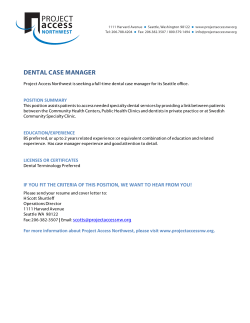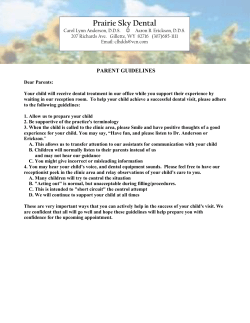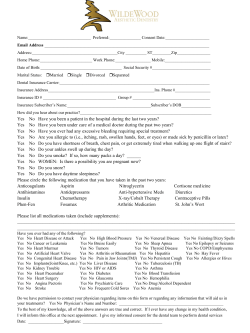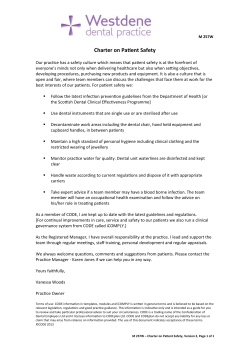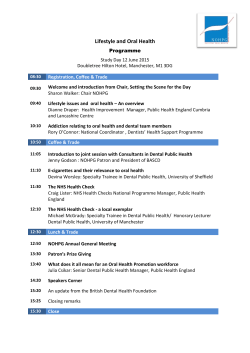
PDF - Scient Open Access
Clinical Microbiology & Case Reports ISSN: 2369-2111 Research Article Disseminated dermatological symptoms in chronic cases of Neurocutaneous Syndrome (NCS) or Morgellons This article was published in the following Scient Open Access Journal: Clinical Microbiology & Case Reports Received February 24, 2015; Accepted March 21, 2015; Published March 24, 2015 Omar M. Amin* Parasitology Center, Inc. (PCI), 11445 E. Via Linda # 2-419, Scottsdale, Arizona 85259, USA Abstract We are reporting on eight cases of chronic Neurocutaneous Syndrome (NCS) exhibiting extreme dermatological symptoms. Dermatological symptoms are usually preceded by intermediate neurological stages of crawling and pin pricking sensations. We have published many articles on NCS but pictures of extreme dermatology and associated cases have not been previously reported. The photos included in this report were taken during initial examination at Parasitology Center, Inc. (PCI) between 1993 and 2004. We have developed a protocol that successfully resolves the symptoms of NCS. “Delusional parasitosis” and Morgellons disease cases should be assigned to NCS and treated as such. The literature on delusional parasitosis dismisses “delusional patients” as psychiatric cases with imaginary external and internal symptoms that feel like parasite movements. We have researched over 1000 “delusional” patients since 1996 at PCI. We have concluded that the internal sensations of crawling and pin-pricking, often confused with parasite movement, are actually caused by toxicity from exposure to toxic chemicals including but not limited to dental materials that interfere with the propagation of normal nerve impulse. We also have evidence that external parasites/organisms including springtails (Collembola), other arthropods, bacteria, and fungi represent only opportunistic infections of skin sites compromised by toxins. The elimination of toxins from the skin will cause breaks that will allow the establishment of external infections. We have described a new pathological disorder that we called Neuro-cutaneous Syndrome because of the neurological and the dermatological symptoms that characterize it. Introduction and Background The terms Morgellons and Neuro-cutaneous Syndrome (NCS) as characterized by Amin [1-13] are used interchangeably, yet cautiously, as their symptoms are very similar. At the Parasitology Center, Inc. (PCI), we have been researching NCS since 1996. Our early reports on this syndrome included the description of a case with many facial opportunistic infections from Oklahoma [1] and the first naming and diagnosis of NCS from 3 more cases, with a special reference to fibers and springtails (Collembola) [2]. By 2003, we were able to provide a comprehensive diagnosis of NCS and establish the link to dental toxins as the causative agents. Amin [3] clarified the nature of action of dental liners (bases) in the causation of NCS neurological and dermatological symptoms. Various versions of this landmark publication were subsequently published elsewhere [4-6]. We established a causal relationship with dental toxins, as well as with other less frequent toxic exposures, developed a protocol, and successfully treated patients. *Corresponding author: Omar M. Amin, Parasitology Center, Inc. (PCI), 11445 E. Via Linda # 2-419, Scottsdale, Arizona 85259, USA, E-mail: omaramin@aol.com Volume 1 • Issue 2 • 009 This epidemic-in-disguise has been routinely misdiagnosed by medical professionals who often label patients as delusional because of their description of their neurological symptoms (actually caused by nerve damage) as having been caused by parasite infections. Amin [7] specifically addressed this issue while discussing the clinical history of 24 NCS patients. Amin [8,9] provided annotated lists of about 360 and 644 dental materials that have been involved in the causation of NCS symptoms. An overview of NCS [10] made special reference to organ system symptomology. Amin [11] further analyzed 18 new NCS cases that have been in various stages of treatment and recovery and have demonstrated that those patients that have followed and completed our protocol have invariably recovered. Among patients experiencing recovery, 15 have shared their experience and perspectives [12]. NCS symptoms stated by 166 patients upon first examination at PCI were reported by Amin [13]. The two most recent publications included new case histories, emphasized the fallacy of the concept of “Delusionary Parasitosis” [14,15], and proposed that cases of “Delusional parasitosis” www.scientonline.org Clin Microbiol Case Rep Citation: Amin OM (2015). Disseminated dermatological symptoms in chronic cases of Neurocutaneous Syndrome (NCS) or Morgellons Page 2 of 5 and Morgellons disease should be assigned to NCS and be treated as such. On one hand, we come across occasional reports supporting our findings. For instance, Kal et al. [16] described an immediate hypersensitivity reaction associated with the mercury component of amalgam restorations. The authors reported that the mercury from amalgam fillings induced an acute reaction which resulted in erythematous lesions, severe burning and itchy sensation and difficulty in breathing. The amalgam restorations were replaced with compatible composite restorations and the symptoms resolved. Follow-up skin patch test results indicated a very strong positive reaction to mercury. Rare instances of delayed, localized allergic reactions have been reported in the literature. On the other hand, there is ample literature describing the reported symptoms of “delusional parasitosis” cases and characterizing patients as psychiatric cases [17-23]. For example, see Aw et al. (2004) [17], Bak et al. (2008) [18], Donabedian (2007) [19], Driscol et al. (1993) [20], Hinkle (2000) [21], Lyell (1983) [22], and Trabert (1995) [23]. The 2 most recent articles are those of Shelomi [24], an entomologist who also reported on a case of photo manipulation of presumed springtail (Collembola: Arthropoda) infections, and Lyons [25], a veterinarian who presented 3 case histories. Materials and Methods Patients were interviewed and clinical and dental histories were taken. Oral cavity, scalp, and skin were examined for signs of compromised tissues and abnormal appearances. Skin swabs were taken from compromised areas for bacterial and fungal culture when applicable. The interview focused on any sources of toxic exposures in a timeline to establish possible associations with clinical symptoms. Patients filled out a lengthy questionnaire addressing neurological, cutaneous, organ system, oral, allergy, and general issues as well as previous dental and related clinical and recreational drug histories. Used dental materials are checked against the OSHA MSDS forms for possible pathological relationships. If the patient is diagnosed with NCS or Morgellons, he/she is given a protocol involving running a dental bio-compatibility test contracted with a Colorado laboratory, and dental rehabilitation and detoxification using homeopathic remedies. The biocompatibility test will determine the reactivity of the patient to known dental materials and suggest replacement chemicals to which the patient is not sensitive. Written informed consent was obtained from the 8 featured patients for use of their information and accompanying images. The photos included in this report were usually taken during initial examination at PCI between 1993 and 2004. Sometimes, however, photos were provided by patients during the height of symptoms at a prior date. Ultimate outcome after diagnosis at PCI and treatment is not indicated in detail in all cases since a number of patients were lost to follow up. However, when applicable, reference is made to patients that we know have followed our protocol and have recovered. Results and Discussion The following is a listing and brief synopses of 8 selected chronic NCS patients with disseminated dermatological symptoms that were associated with incompatible toxic dental Volume 1 • Issue 2 • 009 materials. Patients were referenced by their photos depicting their skin symptoms. LW (Figure 1): LW was a 45 years old white female from Phoenix, Arizona when she saw us at our PCI office in March, 2003. She suffered from movement and biting sensations suspected to be due to scabies in 1999 for which she used Quell, Elimite, and Eurax. Swab culture of her skin sores demonstrated secondary infection with Staphylococcus aureus. Her live in boyfriend was reported to have also been affected. No foreign travel experience was indicated. LW was lost to follow up. MS (Figures 2 and 3): MS is a white female from New Jersey born in 1955. She was diagnosed at PCI in July, 2006 with “classical symptoms of NCS, especially dermatological…” Dermatological symptoms were of constant nature and started in April, 2006. They were of moderate to severe intensities and included open oozing, and painful sores and lesions on the face, ears, neck, chest and arms, and elevated ripples and veins especially on the hands. In May and June, 2006 her neurological symptoms started manifesting at moderate to severe levels of intensities. These included skin irritation, pin-prick, crawling, burning, and compromised memory and vision, and brain fog. She also experienced severe swelling and noted moderate to severe sensitivity to Sulfa, bright light, mold and humidity as is typical of Sulfa allergies. She was fatigued and suffered from insomnia, compromised immune system and some weight loss. A swab culture from her chest was positive for Staphylococcus aureus and S. epidermidis on July 26, 2006. On May 31, 2006, her physical exam and laboratory blood work were normal but she Figures 1-6: Dermatological symptoms of cases 1-4. 1. Skin sores on the legs of LW at the height of symptoms shortly before visiting PCI. 2. Sores on the face of MS at the height of symptoms when she visited us at PCI. 3. MS shortly before the onset of symptoms. 4, 5. Sores on the face and chest of CD when seen in our office. Sores were noted throughout her body. 6. Sores on the face of JK. Similar sores covered the rest of her body. www.scientonline.org Clin Microbiol Case Rep Citation: Amin OM (2015). Disseminated dermatological symptoms in chronic cases of Neurocutaneous Syndrome (NCS) or Morgellons Page 3 of 5 was diagnosed with multiple food allergies with a development of an erythematous rash, with wheat and gluten sensitivities suggestive of Celiac disease. Results of Celiac antibodies tests were negative but she was put on prednisone therapy and glutenfree diet. There was no family history of Celiac disease. On 3/22. Dentist removed and replaced three large amalgam fillings and placed “surface composite on the two front teeth. On 4/4-5. She noticed a small red, raised itchy patch behind her left ear. Also her upper chest became itchy, but no rash. She applied OTC antiitch cream behind ear. Rash continued. On 5/2, she presented to primary physician with red, raised, itch rash. Script was given for Hydroxyzine 25 mg and Mometasone Furoate. On 5/11, she presented to allergist for rash on ears, eyes, nose and chest. On 5/15: rash became so intense and spread across her face, neck, ears, upper chest and inside right foreman. Throat began to itch. Presented to ER. Received a shot of Solumedrol, shot of 50 mg Benadryl and given a script for Pepcid, Prednisone, and an Epi pen. On 5/19, script was given for Celiac spruce antibiotics blood test. On 5/25, rash was worse than when she went to ER, extreme pain and itching. Unable to sleep even with Benadryl round the clock. Scripts given for Avelox and Presudovent. On 5/30, allergist office gave antigen drops X 3 vials. On 6/5, allergist office: presented with severe rash. Evaluation: urticaria. Recommend IV therapy starting same day. Begin IV 25 grams vitamin C plus (2 times per week). GI consult. Repeat Celiac antibody test. On 6/13 “IV 25 grams plus. On 6/15 IV 50 grams plus. On 6/20, script for Ultra Flora, graphite drops and antigen drops. Stated her problem was “allergic dermatitis. On 7/6, At primary physician office: eyelids swollen and slit at the crease. In severe pain whenever the rash was present couldn’t sleep more than a couple of hours because of the pain and pin-pricking feeling. Exhausted, eating only one meal a day, constantly groggy from the antihistamines round the clock. The internet: wondered if there was a connection with having a new dental material placed in 3 teeth. She came across a link to PCI. The case histories and photo’s described her symptoms and looked like her. Symptoms started shortly after having the material placed in her mouth. She has been diagnosed with NCS at PCI. Dr’s still will not read the PCI materials she gave them on 7/19. Her other doctors gave her a punch biopsy of skin on lower left Jaw on 8/17. Pathology report “spongiatic dermatitis” of unknown etiology. Physician debunked the idea of NCS again. On 8/19, dentist removed dental materials placed in her mouth. On 10/7 dentist matched bonding on front teeth, as these were also part of the 3/22 dental work performed. On 10/23, dentist replaced bonding material on front teeth from 3/22.On 11/30, she consulted with new primary physician. (He) encouraged complimentary/alternative therapies. He has not heard of NCS but read the printed materials and recommended to continue with the NCS protocol. MS’s dental history included the treatment on 3/22/06 of four teeth (nos. 8, 15, 18, 19) with Esthet-X improved Micro Matrix Restorative (including Titanium Dioxide and Urethane modified Bis-GMA dimethacrylate) (tooth no. 8); One step (including Biphenyl dimethacrylate and Hydroxyethyl methacrylate), Clearfil composite (including Bisphenol A diglycidylmethacrylate and Triethvleneglycoledimethacrylate), and Biscover liquid polish (no methacrylate based compounds) (teeth no 15, 18, 19). While the bio-compatibility test results indicated that MS was only highly reactive to Esthet-X, we believe that her reactivity may have been to the methacrylate-based compounds in all dental Volume 1 • Issue 2 • 009 materials used except the Biscover polish but definitely to the Titanium dioxide found only in Esthet-X to which she was highly reactive. MS had no other dental work done prior to 3/22/2006. The case MS represents one more case in which the relationship between the dental materials used (cause) and the manifestation of NCS symptoms (effect) is well documented. MS experienced full recovery a few months later. No recurring symptoms have been reported for the last nine years since the onset of the above episodes in 2006 and subsequent recovery. CD (Figures 4 and 5): CD is a white woman from California. She was 52 years old when she came to see us at PCI in September, 2004 when the pictures (Figures 4 and 5), among others, was taken. She was experiencing severe dermatological and neurological symptoms of crawling and pinpricking sensations, as well as heart palpitation, flu-like symptoms, intestinal abnormalities, bowel disturbance, joint and muscular pain, and arthritic symptoms. She was severely allergic to mold and bright light and suffered from fatigue, insomnia, and compromised immune symptoms. She was diagnosed as delusionary, selfinflicting, and was given Prozac. Her first dental work was in 1972. She had partial root canal work in 1980 and 1995 but no dental records were available. Results of swab culture tests from facial sores showed secondary infections with Streptococcus pyogenes and Staphylococcus aureus coagulase positive. Her CBC blood analysis was normal but her hair analysis showed high aluminum, lead, tin levels. CD was given our protocol but did not follow up. JK (Figure 6): JK is a white woman from Wisconsin. She was 54 years old when she came to see us at PCI in March, 2004 when the picture (Figure 6), among others, was taken. She had all the classical dermatological and neurological symptoms of NCS. Her dental history indicated the use of GuttaPercha and Sultan for four root canal procedures between 1996 and 1998. She presented with sores and lesions all over her body. The sores started early in the mid 1990’s but suspected skin “parasites” in the summer of 2003. She has tried Ivermectin, among other skin parasite treatments but at no avail. It was not a parasitic issue. She was given our protocol. A culture of her skin swabs demonstrated a secondary infection with Staphylococcus aureuscoagulose positive. In April, 2005, she wrote that she had gotten much better and that she had developed a website to help others who have this “skin disease;” she called skin parasite. She had manipulated and corrupted what she learned from her experience with us in the most unfortunate way creating expensive science fiction seminars. We are fortunate that she did not give us credit. MM (Figure 7): MM is a white woman from Arizona. Born in 1941, she was 54 years old when she came to see us at PCI in September of 2003 when this picture (Figure 7) was taken. At that time, the sore on her forehead was 26 years old. She was diagnosed with classical dermatological and neurological NCS symptoms. Her first dental work was when she was 11 when living in the Virgin Islands. For the past 20 years prior to seeing us, she experienced low grade sinus infection, teeth grinding, weight loss, occasional skin discoloration, skin eruptions, biannual flu symptoms of six week duration, joint discomfort, smelly feet and arm pits, and a lesion in left nostril that went away in two months after treatment with Tea Tree Oil. The most prominent was a coalesced large oozing sore on www.scientonline.org Clin Microbiol Case Rep Citation: Amin OM (2015). Disseminated dermatological symptoms in chronic cases of Neurocutaneous Syndrome (NCS) or Morgellons Page 4 of 5 less effective. Most effective have been Chaparral, Tea Tree Oil, Thyme oil, GSE (grapefruit seed extract), sangre de drago, food grade peroxide, eucalyptus, parasite and fungal compounds as well as soapy water dabbed with de-natured alcohol. Wood ashes reduced burning sensations. Despite the fact that no dental records were available during MM’s visit to PCI, or made available at a later date, we believe that she was a classical NCS case with multiple opportunistic infections that kept her major sore “alive” especially that her medicinal regimens lacked any detoxification remedies. Opportunistic infections are the byproducts of this toxicity syndrome and not its cause. MM was looking for this elusive biological cause and did not follow up. She would have been in a much better place if she did. Figures 7-12: Dermatological symptoms of cases 5-8. 7. Prominent lesion on the forehead of MM. 8. Sores on the face of SC seen during her visit to PCI. 9,10. The upper and lower back of JA showing the dissemination of sores there and elsewhere on her body. 11,12. Legs and lower back of BG covered with sores. Sores covered the rest of his body. her forehead which started in 1977 when she lived in Florida and Maine. She started feeling biting sensations at that time. Initially, activity (running in a cycle of 17-27 days) started with the skin becoming shiny and red in perfect circle. This is followed by biting sensations where small bumps appeared. The sensations turned into stinging and burning, like acid, then the sore occasionally crusted. Tea Tree Oil helped some. The crust got thicker followed by the elimination of clear sticky liquid turning color to greenish yellow escaping from under the crust. The oozing area often developed additional crusty area. Symptoms were aggravated with any attempt to remove the crust. A period of 6-8 days of calm followed. The sore was initially identified as basal cell carcinoma but no cancer was detected after two surgeries and a pathology report. When cultured at PCI and in Maine, the sore yielded high grade infections with Candida sp., Staphylococcus aureus coagulase positive, and Staphylococcus coagulase negative (S. epidermidis). Treatment with Erythromycin and Cipromycin to which her infections were susceptible yielded no relief. Her cat and dog had similar lesions on their back. The cat eventually died and the dog survived when MM moved to Arizona. Holistic approaches (Homeopathy, Naturopathy, Acupuncture, Osteopathy, Chelation, Low intensity laser treatment, Chiropractic, N.A.E.T., and MSA (Meridian Stress Assessment) were attempted before she came to see us at PCI. None provided any significant improvement. Past har analysis showed excessive aluminum. Urinalysis showed elevated arsenic, lithium, mercury, and phosphorus. N.A.E.T. and MSA testing showed reaction to parasites, fungus, insects, viruses, meningitis, and vaccination. Treatment for meningitis showed a dramatic relief of symptoms. Laser treatment was progressively Volume 1 • Issue 2 • 009 SC (Figure 8): SC is a white woman from Mississippi. She was born in April, 1976 and was 31 years old when she came to see us at PCI in October, 2007 when this picture (Figure 8) was taken. She complained from painful itchy sores especially on the face that “seemed to tunnel and connect with others” since September, 2007. The sores broke out with extremely itchy rash from the shoulders to the arms and legs from the mid-thighs to the ankles. She was medicated with cortisone shots, hydroxyzine, and topical creams for the itch. Her mother also suffered from NCS and they were both declared delusional. SC was placed on psychotherapy but there was no relief. In our PCI questionnaire, she ranked with most elevated levels of open lesions, painful sores, itchy pimples, elevated ripples, tracks, bumps, skin peeling, and with elevated levels of pin-prick sensations, crawling sensations, redhot face, and vision problems. She suffered from severe insomnia, psychological trauma, and night fever and sweats. Her dental history indicated no cavities before the age of 21. She had 7 fillings with composites since she had a car accident in 2001 that caused damage to her face from shattered glass. Her previous treatments included Prozac, Zoloff, Celexa, Pakil and Xanax for anxiety that made her more depressed. She quit Marijuana in 2004. She took no cocaine since April, 2004. She was taking 100 mg of Lamictal 2 X day and 20 mg of amphetamine salts 2 X day as needed at the time of her visit to PCI. We have reported on the effect of recreational drugs on symptomology of NCS and have no dental history for MM to implicate particular dental chemicals involved in her case. We got her started on our protocol during her visit. Bacteriological cultures from her face (nose) and chest showed infections with Staphylococcus aureus coagulase positive. A culture from SC’s mother (JS)’ nasal blood was showed infections with the same strain of S. aureus as well as with Candida sp. and Klebsiella sp. Another culture of the skin cream that JS used also showed contamination with the same strain of S. aureus and Candida sp.; a case of cross contamination. The case of SC was lost to follow up after her initial use of elements of our protocol. JA (Figures 9 and 10): JA is a white female from Texas. She was 48 years old when she came to see us at PCI in December, 2006 when those pictures (Figures 9 and 10), among others, were taken. She presented with severe dermatological (open oozing lesions, itchy pimples, elevated ripples and veins, tracks, bumps, and scalp sores) beginning in January, 2002 and neurological (skin irritation, and pin-prick, crawling and movement sensations) also beginning in January, 2002. She also experienced heart www.scientonline.org Clin Microbiol Case Rep Citation: Amin OM (2015). Disseminated dermatological symptoms in chronic cases of Neurocutaneous Syndrome (NCS) or Morgellons Page 5 of 5 palpitation, high blood pressure, flu-like symptoms, intestinal abnormalities, bowel disturbances, and other systemic problems including coughing, tight chest, swelling, joint and muscular pain, liver dysfunction, and arthritic symptoms beginning in 2002. See Amin (2006b, 2007) for organ system symptoms. Her oral cavity showed inflamed gray gum tissue, dental decay and abscesses, and gray teeth beginning earlier in 1997. Her initial dental work began in 1981-1982. Some of the dental materials used included Esthet X flow, Prime and Bond NT, ED Primer-liquid A. Panavia 21, Oxyguard II. Panavia F, Caulk 34% tooth conditioner gel, and Concrete. See Amin (2012) for the toxic ingredients in these chemicals. Following the satisfactory diagnosis of JA as an NCS case, we got her started on the PCI protocol. She was subsequently lost to follow up. BG (Figures 11 and 12): BG is a white male from New Mexico. He was 41 years old when he came to see us at PCI in June, 2004 when these pictures (Figures 11 and 12), among others, were taken. He complained from extensive skin lesions with elevated rims, burning eyes, nasal congestion, recurrent upper respiratory infection, weight loss, fatigue, food allergies, malabsorption, gas, burning red face, memory loss, and blurry vision. The latter three symptoms are typical neurological symptoms of NCS. Dental records for BG were not available but a comprehensive dental evaluation performed in April, 2004 included tests for lymph and circulatory system, dental system (pulp, mandibles, maxilla, sinuses), limbic system, peripheral nerves, lymph vessels. Teeth of concern were identified and specific problem teeth hierarchy were noted. Critical allergic reactivity and intolerant reactivity, metal toxins, most problematic and most reactive teeth were also identified. This dental evaluation protocol was interesting but it was not a bio-compatibility test and specific highly reactive data necessary for subsequent dental rehabilitation was not available. A swab culture of facial sores showed infection with Staphylococcus aureus coagulase positive. On May, 24, 2003, BG wrote a follow up indicting that he had all his crowns removed. Three out of four crowns had large amounts of amalgam underneath. He also had all fillings previously changed to composites cleaned out again and new material put in. He had two overlays on his front teeth changed as he did not know what kind of glue and porcelain were used. BG followed up with our protocol for a while but we received no further correspondence from him. References 1. Amin OM. Facial cutaneous dermatitis associated with arthropod presence. Explore. 1996;7: 62-64. 2. Amin OM. Neuro-cutaneous Explore.2001;10: 55-56. Syndrome (NCS): a new disorder. 3. Amin OM. On the diagnosis and management of Neuro-cutaneous Syndrome (NCS), a toxicity disorder from dental sealants. Explore. 2003;12: 21-25. 4. Amin OM. Dental sealant toxicity: Neurocutaneous Syndrome (NCS), a Dermatological and neurological disorder. Holist Dent Assoc J. 2004;1-15. 5. Amin OM. On the diagnosis and management of Neuro-Cutaneous Syndrome, a toxicity disorder from dental sealants. J Calif Dent Assoc. 2004;32(9):657-663. 6. Amin OM. On the diagnosis and management of Neuro-cutaneous Syndrome (NCS), a toxicity disorder from dental sealants. Townsend Lett. 2006;276: 85-90. 7. Amin OM. On the course of Neurocutaneous Syndrome (NCS) and its pseudodiagnosis by medical professionals. Explore. 2004;13: 4-9. 8. Amin OM. Dental products causing Neuro-cutaneous Syndrome (NCS) symptoms in NCS patients. Explore. 2005;14: 57-64. 9. Amin OM. A comprehensive study of dental materials and their toxic ingredients associated with Neuro-cutaneous Syndrome (NCS) and Morgellons, with notes on research background. Explore. 2012; 21: 14-23. 10.Amin OM. An Overview of Neuro-cutaneous Syndrome (NCS) with a special reference to symptomology. Explore. 2006; 15: 41-49. 11.Amin OM. The face of Neuro-cutaneous Syndrome (NCS): new cases, recovery, and perspectives. Explore. 2007; 16: 54-64. 12.Amin OM. Recovery from Morgellons and Neuro-Cutaneous Syndrome (NCS): patients perspectives. Explore. 2009; 18: 25-33. 13.Amin OM. In their own words OR: symptoms of Morgellons and NeurocutaneousSyndrome (NCS) upon first examination at the Parasitology Center, Inc. (PCI). Explore. 2010; 19: 24-31. 14.Amin, OM. The misdiagnosis Parasitol,Photon.2014; 104: 139-144. of “delusional parasitosis.” J 15.Amin OM. The case against delusional parasitosis. J Life Sc. 2014; 8(9): 731739. 16.Kal BI, Evcin O, Dundar N, Tezel H, Unal I. An unusual case of immediate hypersensitivity reaction associated with an amalgam restoration. Br Dent J. 2008; 205(10):547-550. 17.Aw D, Thong J, Chan HL. Delusional parasitosis: Case series of 8 patients and review of the literature. Ann Acad Med Singapore.2004;33(1):89-94. 18.Bak R, Tumu P, Hui C, Kay D, Burnett J, Peng D. A review of delusions of parasitosis, Part 1: Presentation and diagnosis. Cutis.2008;82(2):123-130. 19.Donabedian H. Delusions of parasitosis. Clin Infect Dis. 2007;45:131-134. 20.Driscoll MS, Rothe MJ, Grant-Kels JM, Hale MS. Delusional parasitosis: a dermatologic, psychiatric, and pharmacologic approach. J AmerAcadDermatol. 1993;29(6): 1023-1033. 21.Hinkle NC. Delusionary parasitosis. AmerEntomol. 2000;46:17-25. 22.Lyell A. Delusions of parasitosis. Brit J Dermatol. 1983;108(4):485-499. 23.Trabert W. 100 years of delusional parasitosis. Meta-analysis of 1,223 case reports. Psychopathol. 1995;28(5):238-246. 24.Shelomi M. Evidence of photo manipulation in a delusional parasitosis paper. J Parasitol. 2013;99(3):583-585. 25.Lyons ET. Delusional parasitosis. J Parasitol Newsletter. 2013;35:7-11. Copyright: © 2015 Amin OM. This is an open-access article distributed under the terms of the Creative Commons Attribution License, which permits unrestricted use, distribution, and reproduction in any medium, provided the original author and source are credited. Volume 1 • Issue 2 • 009 www.scientonline.org Clin Microbiol Case Rep
© Copyright 2025


